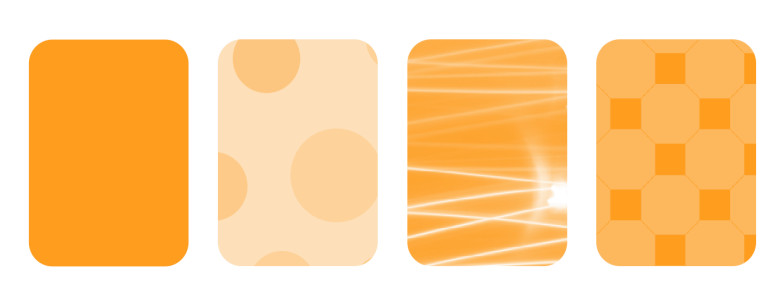Pattern transparency
There are three types of pattern transparency: vector pattern, bitmap pattern, and two-color pattern.
Vector pattern transparencies are pictures composed of lines and fills, instead of dots of color like bitmaps. These vector graphics are smoother and more complex than bitmap images and are easier to manipulate.
Bitmap pattern transparencies are color pictures composed of patterns of light and dark or differently colored pixels in a rectangular array.
Two-color pattern transparencies are simple pictures composed of "on" and "off" pixels. The only shades included in the picture are the two that you assign.
From left to right: Original object with a vector pattern, bitmap-pattern, and two-color pattern transparency applied.
You can choose pattern transparencies from a personal or shared library. You can browse the available transparency patterns, search by keyword, mark patterns as favorites, and sort patterns. You can also download additional fill packs, which can be used as transparency patterns. For more information, see Find and view fills and transparencies.
You can modify pattern transparencies to suit your needs. For example, you can create seamless patterns and adjust the pattern parameters, such as the pixel configuration along the edge of the tile and the brightness, luminance, and color contrast of the pattern.
You can also create your own patterns. For example, you can create patterns from areas of the workspace or images that you import. Vector and bitmap patterns are made up of smaller units called tiles. Depending on the size of the object, the transparency may consist of one or more tiles. The pattern is created by repeating the tile to fill up the object.
After you modify or create a pattern transparency, you can save it for future use. For more information, see Save fills and transparencies.
To apply a vector or bitmap pattern transparency
For information about how to find transparencies in the Transparency picker, see To find, filter, and sort fills and transparencies.
To apply the transparency only to the fill or the outline of the object, click the Fill button or the Outline button
.
You can also click the Transparency tool in the toolbox and use the controls on the property bar.
To modify a vector or bitmap transparency
To save the edited transparency, click the Save as new button .
You can also click the Transparency tool in the toolbox and use the controls on the property bar.
You can also skew or rotate tiles by clicking the Transparency tool in the toolbox, selecting an object, and dragging the skewing or rotation handles to change the appearance of the pattern.
To apply a two-color pattern transparency
To apply the transparency only to the fill or the outline of the object, click the Fill button or the Outline button
.
To modify the pattern, click the Edit transparency button , and specify the settings you want.
You can also click the Transparency tool in the toolbox and use the controls on the property bar.
